|
Unit 6: Background to the Mysteries Eleusinian Mysteries Apollo at Delphi Tour of Delphi Timeline of Delphi Festival Calendar |
| Return to Front Page |
|
Background to the Eleusinian Mysteries |
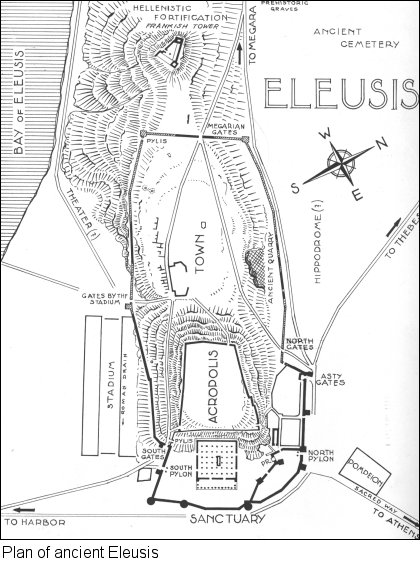 |
| Historical background: |
Eleusis occupied a strategic location on the Bay of Eleusis near Athens. 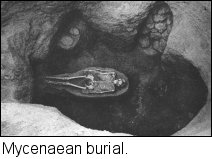 The city was not very vulnerable to attack by sea thanks to its geography, and was accessible to major population centers, since the roads connecting Athens with the Peloponnese and central and northern Greece all passed through Eleusis. Therefore, the city held a strong position vis-a-vis Athens as well as the rest of Greece. The city was not very vulnerable to attack by sea thanks to its geography, and was accessible to major population centers, since the roads connecting Athens with the Peloponnese and central and northern Greece all passed through Eleusis. Therefore, the city held a strong position vis-a-vis Athens as well as the rest of Greece.Early in the second millennium B.C.E., there were one or more wars between Eleusis and Athens, with Athens prevailing, though with great difficulty. Thus, Eleusis fell into the sphere of Athenian influence. During the Mycenaean Age, roughly 1500-1100 B.C.E., the village was expanded, as evidenced by a large burial site, and it was at this time that the cult of Demeter was likely established. 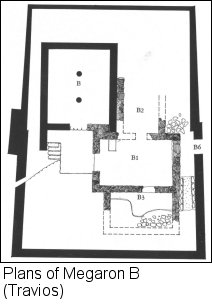 A building known as Megaron B, dated to this period, was probably the original Temple of Demeter. It exists above the Kallichoron, the well above which the Homeric Hymn specifies that the temple was built. (line 272) Fortification walls probably were built during this time period, though they have never been excavated. A building known as Megaron B, dated to this period, was probably the original Temple of Demeter. It exists above the Kallichoron, the well above which the Homeric Hymn specifies that the temple was built. (line 272) Fortification walls probably were built during this time period, though they have never been excavated.In the second half of the seventh century B.C.E., during the Archaic period, Eleusis achieved independence. But soon the Athenian leader Solon managed to retake it. He and subsequent Athenians such as Peisistratos (mid-6th c.) made improvements to the telesterion (temple) (see below, Plans of the Telesterion A and B). Eleusis remained under constant Athenian control until the Persian Wars of the fifth century. In 480-479, the Persians destroyed most of the city and sanctuary by fire. Once the Persians were defeated, Kimon, a leading Athenian statesman and general of the early to middle 5th century B.C.E., rebuilt the sanctuary and rebuilt the Telesterion using much of the remains of the Peisistratean Telesterion. (see below, Plans of the Telesterion C) 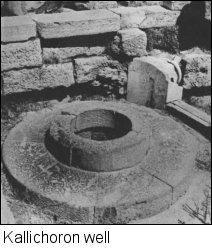 During the confusion of a period of general civil war in Attica (the region surrounding Athens), around 400 B.C.E. Eleusis briefly declared its independence. However, it was soon brought back under Athenian influence and saw a period of great expansion. Little expansion of Eleusis took place between this time and when the Romans took over Eleusis several centuries later. They greatly expanded the sanctuary and incorporated it into their own religion. Many important Romans, such as Augustus himself, took part in the Mysteries. |
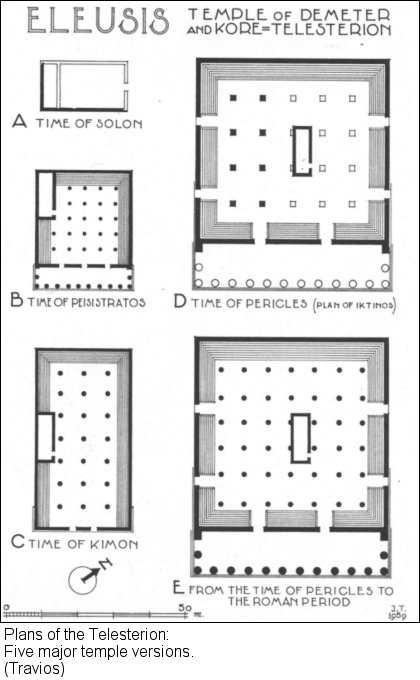 |
| Officials of the Eleusinian Mysteries |
|
Throughout the Greek world (and later, the Roman world), the Eleusinian Mysteries were one of the most important religious festivals. Details of the Mysteries are sketchy due primarily to the fact that they were secret rites and could not be told to non-initiates. The Greeks believed that the goddess herself doled out the punishments. Many specialized officials were needed to preside over the Mysteries, a good indication of how well-developed and important they were. For a detailed description of the rites over which these officials preside, see The Eleusinian Mysteries. An Athenian magistrate, the Archon Basileus, and several of his assistants were in charge of the non-religious aspects of the celebration. The chief religious official, the Hierophant, was the high priest at Eleusis for life and was always from the family of the Eumolpids, the family descended from Eumolpus, the mythical ruler of Eleusis who appears in the Homeric Hymn to Demeter. (line 154) He was the one who revealed the Hiera (Sacred Objects) to initiates (we do not know what objects the Hiera actually were). The Hierophant alone could decide whether to reject a potential initiate. He could marry, but during the celebration, he had to be chaste. In Roman times, he was a hieronymos, meaning that his name could not be uttered under the threat of severe punishment. The Hierophantides were two priestesses, one for Demeter and one for Persephone. They too had the privilege of hieronymy, were from the family of the Eumolpids, and held their positions for life. The Priestess of Demeter belonged to the family of the Eumolpids or the Philleidae, and lived in the Sacred House at Eleusis. She held the office for life and her name was used to date events and inscriptions. She even had the license to dispute with the Hierophant over sacrificial procedures. The Priestesses Panageis were women ministers within the cult, though their role is uncertain. They seemed to have the privilege of being allowed to touch the Hiera. Other important officials included the Dadouchos, the torchbearer (see Hymn to Demeter, line 61) 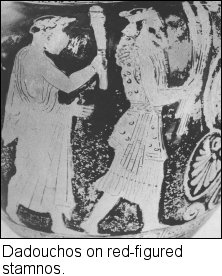 ; the Hierokeryx, the herald of the initiates; and the Priest at the Altar, who was probably responsible for the sacrifice of animals. ; the Hierokeryx, the herald of the initiates; and the Priest at the Altar, who was probably responsible for the sacrifice of animals.Lesser officials in the Mysteries included the Phaethyntes, a man who cleaned the statues of the gods; the Hydranos, who purified the initiates with water; the Neokoros, who was in charge of the cleaning and decorating of the sanctuary; there were also numerous other priests and priestesses responsible for the singing involved in the celebration. Lastly, every year, one young boy or girl from an aristocratic Athenian family was voted to be initiated at the State's expense. This child probably performed the role of an "altar boy". |
| Sources: Miles, Margaret M. The Athenian Agora. American School of Classical Studies Publications, 1998. Mylonas, George E. Eleusis and the Eleusinian Mysteries. Princeton University Press, 1961. |
| Relevant genealogical information: |
|
|
| Timeline of Relevant Events |
|
|
|
Copyright 2000-2020 Peter T. Struck. No portion of this site may be copied or reproduced, electronically or otherwise, without the expressed, written consent of the author. |